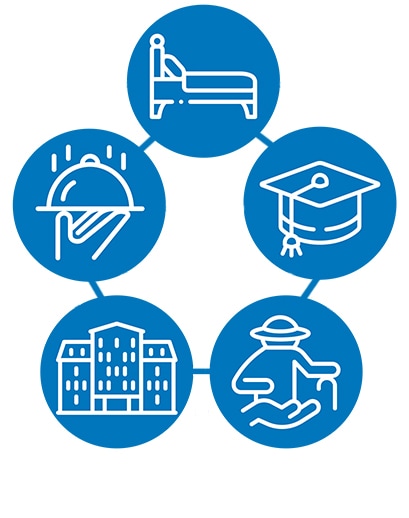The Benefits of Cleaner, Healthier Education Environments and How to Achieve Them
Six ways that cleaner, healthier schools help deliver value for students, staff, schools and our society as a whole.

On December 1, 2022, this article was updated to include more up to date public health information on the rise of RSV, flu and COVID-19.
The much talked about ‘tripledemic’ of flu, COVID-19 and RSV has taken hold in the Northern hemisphere this winter. In North America cases of RSV have increased rapidly since early fall and pediatric hospitalizations have reached levels typically seen later in the year19 In the absence of COVID prevention mandates and a decline in infection prevention behaviors we have also seen a surge in influenza20 and COVID-19 cases21. All three viruses have commonalities in symptoms and transmission and can have devastating effects on our most vulnerable. Children spend the majority of their awake hours in school22 so creating and maintaining a cleaner and healthier environment in schools, daycares and afterschool programs can create a host of benefits.
Here are six ways that cleaner, healthier schools help deliver value for students, staff, schools and our society as a whole:
Help Reduce Student Absenteeism
- The typical elementary school student battles 8-10 cold and flu cases every year, leading them to roughly five absences per year.1 That all adds up to more than 22 million school days lost annually to the common cold — and more than 38 million annual absences from the flu.2 And we haven’t even talked about Gastrointestinal (GI) illnesses like Norovirus, which are second only to the common cold in causing absences among students and staff.3 More consistent and rigorous cleaning protocols — from air filtration and floor cleaning to remove dust and allergens, to robust hand hygiene programs, to regular sanitization and disinfection of high-touch surfaces — can directly help combat these highly transmissible illnesses and reduce student absenteeism. In fact, one study found that simple hand-washing education can reduce student absenteeism from GI illnesses by anywhere from 29-57%.4 The academic benefits of reduced absenteeism are implicit but consider this financial impact: U.S. schools lose $10.7 billion each year due to student absenteeism, as federal funding is allocated based on average student attendance counts.5
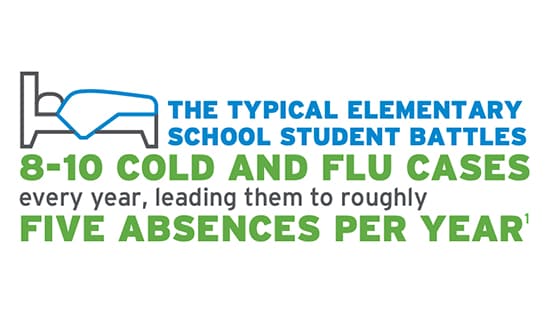
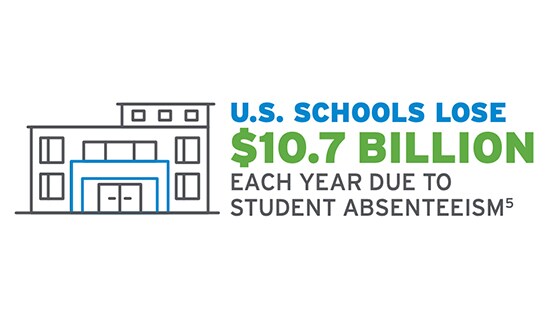
Help Reduce Staff Absenteeism (and Presenteeism)
Teachers are exposed to the same infectious disease risks as students, so it’s not surprising that both students and teachers average around five absences per year.6 Financially, those teacher absences cost the U.S. around $25 billion every year.7 Teacher absences have also been linked to reduced academic performance among students.8 Cleaner, healthier school environments can help reduce absenteeism among staff as well as students. This also helps mitigate presenteeism — the challenge of staff coming to school while still sick, which can both decrease productivity and promote the cycle of infection among others in the school environment.
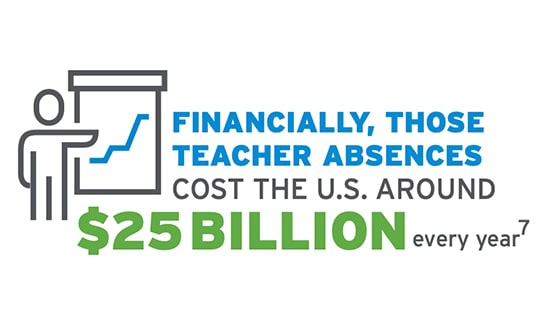
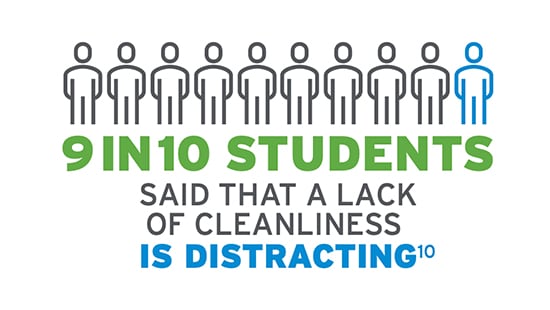
Help Improve Student Attention/Behavior
Cleaner, healthier school environments aren’t just about helping to prevent students from getting sick and missing days. “Clean” also helps improve the attitudes, perspectives, concentration and motivation of students in the classroom.9 In a 2008 study, nearly 9 in 10 students said that a lack of cleanliness is distracting — and believed that a high level of cleanliness would create a better environment to foster their learning and academic achievement.10
Enhance Academic Performance
A comprehensive review of more than 30 research studies on the impact of cleanliness in schools concluded that “cleanliness can affect student health and performance,” noting the clear links between “clean” schools and academic performance of students.11 The meta-study found that students maintained higher grades and better graduation rates in cleaner environments.
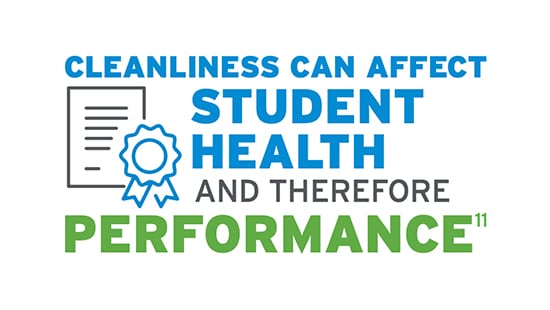
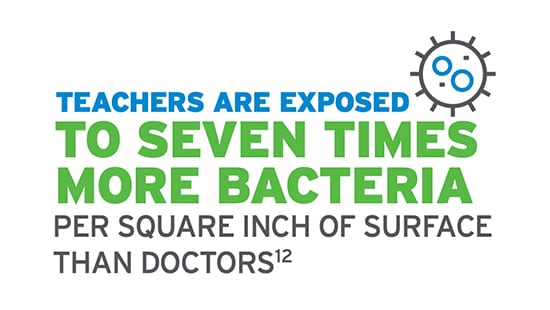
Elevate Staff Satisfaction & Retention
Schools are always working to attract and retain exceptional teachers and staff. Teachers are exposed to seven times more bacteria per square inch of surface than doctors.12 One way to improve staff retention in schools is to tackle these health risks head on. A Stanford study found that improving the cleanliness of school environments can help reduce staff turnover rates.13
Help Optimize Budgets & Bottom Lines
Doing more can often result in spending more. But when it comes to cleaning in schools, more can actually cost less. Research suggests that daily, systematic cleaning of school environments can ultimately reduce the overall cost of the custodial or facility management program by nearly 50%.14 One reason is that effective daily cleaning helps reduce the need for more time- and cost-intensive deep cleaning. Another cost benefit: Consistent, thorough cleaning helps protect facilities from excessive wear and damage — and helps keep high-cost equipment like HVAC systems performing better, longer — to protect some of schools’ biggest infrastructure investments.
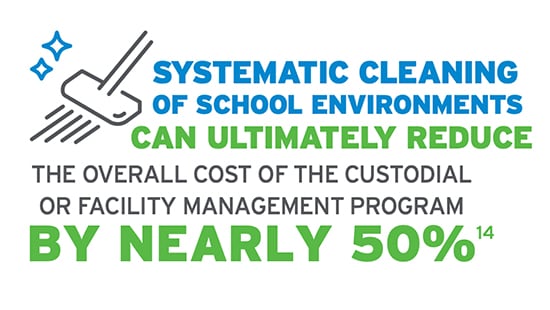
Clean Also Helps Improve the Attitudes, Perspectives, Concentration and Motivation of Students15
3 Critical Lessons for Helping Create Cleaner, Healthier Schools
The six points above make the importance of cleaner school environments clear, but how do you achieve these outcomes? Fortunately, we’ve learned some important lessons helping our education customers over the years. Here are three best practices for creating cleaner, healthier schools:
- Clean air is critical — but surface cleaning still matters
We now know that COVID-19 does not effectively spread via contaminated surfaces. But the unfortunate reality is that there are many other infectious diseases that are easily spread through person-to-surface-to-person contact. Experts say contaminated surfaces are one of the most common ways colds are spread.16 Flu, strep
throat and RSV can also be passed through contaminated surfaces. And while most respiratory viruses only survive on surfaces for hours to days, some of the most common GI pathogens like Norovirus and Rotavirus can live on surfaces for months.17 That’s why the CDC still makes surface cleaning, sanitization and disinfection top
priorities for infection prevention in schools.18 - Choose the right products — understand sanitization vs. disinfection
Even after the pandemic brought increased attention to heightened cleaning protocols, it’s still easy to confuse these terms — to use sanitizing and disinfecting interchangeably, for example. Sanitizers are substances that reduce bacteria by significant numbers but do not destroy or eliminate all bacteria. Disinfectants are substances that destroy or irreversibly inactivate bacteria, fungi and viruses.* Make sure you understand when (and which surfaces) you should be sanitizing versus disinfecting. Just as importantly, make sure you’re using the right product — and following the product label to the exact specifications in terms of surfaces, pre-cleaning, contact or “kill” times, etc. Otherwise, you’re not getting the protection you need. - Vendor partners can help ease the burden
With augmented cleaning protocols and other heightened standards and expectations, savvy school facility managers are leaning on trusted vendor partners, including their cleaning chemical vendors. Leading vendors are partnering with schools to provide science-based guidance and best practices — from which products to use, to which surfaces to focus on. All school facility managers should make the most of their vendors and look for ways these trusted partners can help ease higher burdens to help them drive continued improvements in the cleanliness, healthiness and safety of their environments.
Simple Steps Can Make a Big Difference
The heightened requirements, risks and worries all add to the already stressful challenges in schools. By keeping the three key lessons above in mind as you navigate this school year, you can take simple steps to create cleaner, healthier school environments — without overwhelming your staff and your budgets.
See how Ecolab can help you achieve a cleaner, healthier school environment, visit ecolab.com/education
- www.issa.com/certification-standards/issa-clean-standards/clean-standard-k-12
- www.issa.com/certification-standards/issa-clean-standards/clean-standard-k-12
- healthyschoolshealthypeople.org
- healthyschoolshealthypeople.org
- www.happi.com/issues/2019-04-01/view_features/the-impact-of-hand-hygiene-on-school-absenteeism
- www.issa.com/certification-standards/issa-clean-standards/clean-standard-k-12
- www.issa.com/certification-standards/issa-clean-standards/clean-standard-k-12
- www.brookings.edu/blog/brown-center-chalkboard/2020/01/27/we-should-be-focusing-on-absenteeism-among-teachers-not-just-students/
- Campbell, J. L., and Bigger, A. S. (2008). “Cleanliness & learning in higher education” Facilities Manager, 24 (4) p. 28-36.
- Campbell, J. L., and Bigger, A. S. (2008). “Cleanliness & learning in higher education” Facilities Manager, 24 (4) p. 28-36.
- www.osstf.on.ca/en-CA/publications/research-studies/school-environment
- Gerba, C. P. The Burden of Norovirus in Schools; Cengage Learning, 2016
- epa.stanford.edu/content/how-teaching-conditions-predict-teacher-turnover-california-schools
- simoninstitute.org/clean-schools-initiative/
- Campbell, J. L., and Bigger, A. S. (2008). “Cleanliness & learning in higher education” Facilities Manager, 24 (4) p. 28-36.16. https://healthyschoolshealthypeople.org
- healthyschoolshealthypeople.org/
- www.happi.com/issues/2019-04-01/view_features/the-impact-of-hand-hygiene-on-school-absenteeism/
- www.cdc.gov/flu/school/guidance.htm
- RSV Surveillance Data - NREVSS | CDC
- FluNet Summary (who.int)
- Covid in the U.S.: Latest Maps, Case and Death Counts - The New York Times (nytimes.com)
- https://www.federalreserve.gov/econres/notes/feds-notes/how-do-children-spend-their-time-time-use-and-skill-development-in-the-psid-20200526.html
*Always use EPA approved sanitizers and disinfectants with the appropriate approved claims


